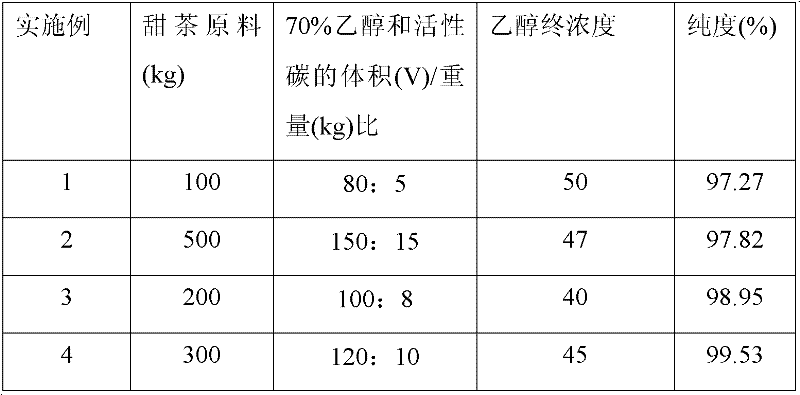Method for extracting rubusoside from sweet tea leaves
A technology of sweet tea and sweet tea, which is applied in the field of natural product chemistry, can solve problems such as the limitation of sweet tea in food, and achieve the effects of reducing production costs, high purification efficiency, and easy operation
- Summary
- Abstract
- Description
- Claims
- Application Information
AI Technical Summary
Problems solved by technology
Method used
Image
Examples
Embodiment 1
[0027] Example 1: Grind and dry 100 kg of sweet tea, add 300 L of 45% ethanol, heat and reflux at 65 ° C for 2 h, filter twice with three layers of gauze, filter with a ceramic membrane, concentrate under reduced pressure to 50 L (no ethanol smell), and then add large pores to the concentrate Adsorbed resin LSA-40 column, eluted with 70% ethanol to obtain the eluate, and concentrated the eluate to dryness. Then heat and dissolve with 80L of 70% ethanol, add 5kg of granular activated carbon for decolorization for 30min, then concentrate to dryness, heat and dissolve with 2L of 90% ethanol, add hot water and mix until the final concentration of ethanol is 50%, then crystallize at room temperature for 24h, filter Crystals were obtained, and then recrystallized to obtain sweet tea samples.
[0028] After testing, the Agilent1100 high performance liquid chromatograph, the chromatographic column is Hypersil ODS (150mm×4.6mm, 5μm), the mobile phase is 65% methanol aqueous solution; t...
Embodiment 2
[0030] Crush and dry sweet tea 500kg, add 45% ethanol 600L, heat and reflux at 65°C for 2 hours, filter twice with three layers of gauze, filter with ceramic membrane, concentrate under reduced pressure to 100L (no ethanol smell), and then apply macroporous adsorption resin LSA- 40 columns, eluted with 70% ethanol to obtain the eluate, and concentrated the eluate to dryness. Then heat and dissolve with 150L of 70% ethanol, add 15kg of activated carbon to decolorize for 30min, then concentrate to dryness, heat and dissolve with 6L of 90% ethanol, add hot water until the final concentration of ethanol is 47%, crystallize at room temperature for 24h, filter to obtain crystals, and then Carry out recrystallization to obtain sweet tea element sample. Purity detection was carried out according to the method of Example 1, and the purity was 97.82%. The results are shown in Table 1.
Embodiment 3
[0032] Crush and dry 200kg of sweet tea, add 200L of 45% ethanol, heat and reflux at 65°C for 2 hours, filter twice with three layers of gauze, filter with ceramic membrane, concentrate under reduced pressure to 50L (no ethanol smell), and then apply macroporous adsorption resin LSA- 40 columns, eluted with 70% ethanol to obtain the eluate, and concentrated the eluate to dryness. Then heat and dissolve with 100L of 70% ethanol, add 8kg of activated carbon to decolorize for 30min, then concentrate to dryness, heat and dissolve with 3L of 90% ethanol, add hot water until the final concentration of ethanol is 40%, crystallize at room temperature for 24h, filter to obtain crystals, and then Carry out recrystallization to obtain sweet tea element sample. Purity detection was carried out according to the method of Example 1, and the purity was 98.95%. The results are shown in Table 1.
PUM
 Login to View More
Login to View More Abstract
Description
Claims
Application Information
 Login to View More
Login to View More - R&D
- Intellectual Property
- Life Sciences
- Materials
- Tech Scout
- Unparalleled Data Quality
- Higher Quality Content
- 60% Fewer Hallucinations
Browse by: Latest US Patents, China's latest patents, Technical Efficacy Thesaurus, Application Domain, Technology Topic, Popular Technical Reports.
© 2025 PatSnap. All rights reserved.Legal|Privacy policy|Modern Slavery Act Transparency Statement|Sitemap|About US| Contact US: help@patsnap.com



